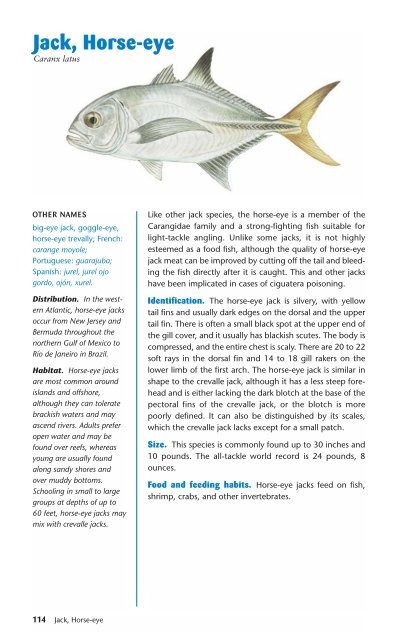Ken Schultz's Field Guide to Saltwater Fish - Macaw Pets store
Ken Schultz's Field Guide to Saltwater Fish - Macaw Pets store
Ken Schultz's Field Guide to Saltwater Fish - Macaw Pets store
Create successful ePaper yourself
Turn your PDF publications into a flip-book with our unique Google optimized e-Paper software.
Jack, Horse-eye<br />
Caranx latus<br />
OTHER NAMES<br />
big-eye jack, goggle-eye,<br />
horse-eye trevally; French:<br />
carange moyole;<br />
Portuguese: guarajuba;<br />
Spanish: jurel, jurel ojo<br />
gordo, ojón, xurel.<br />
Distribution. In the western<br />
Atlantic, horse-eye jacks<br />
occur from New Jersey and<br />
Bermuda throughout the<br />
northern Gulf of Mexico <strong>to</strong><br />
Río de Janeiro in Brazil.<br />
Habitat. Horse-eye jacks<br />
are most common around<br />
islands and offshore,<br />
although they can <strong>to</strong>lerate<br />
brackish waters and may<br />
ascend rivers. Adults prefer<br />
open water and may be<br />
found over reefs, whereas<br />
young are usually found<br />
along sandy shores and<br />
over muddy bot<strong>to</strong>ms.<br />
Schooling in small <strong>to</strong> large<br />
groups at depths of up <strong>to</strong><br />
60 feet, horse-eye jacks may<br />
mix with crevalle jacks.<br />
114 Jack, Horse-eye<br />
Like other jack species, the horse-eye is a member of the<br />
Carangidae family and a strong-fighting fish suitable for<br />
light-tackle angling. Unlike some jacks, it is not highly<br />
esteemed as a food fish, although the quality of horse-eye<br />
jack meat can be improved by cutting off the tail and bleeding<br />
the fish directly after it is caught. This and other jacks<br />
have been implicated in cases of ciguatera poisoning.<br />
Identification. The horse-eye jack is silvery, with yellow<br />
tail fins and usually dark edges on the dorsal and the upper<br />
tail fin. There is often a small black spot at the upper end of<br />
the gill cover, and it usually has blackish scutes. The body is<br />
compressed, and the entire chest is scaly. There are 20 <strong>to</strong> 22<br />
soft rays in the dorsal fin and 14 <strong>to</strong> 18 gill rakers on the<br />
lower limb of the first arch. The horse-eye jack is similar in<br />
shape <strong>to</strong> the crevalle jack, although it has a less steep forehead<br />
and is either lacking the dark blotch at the base of the<br />
pec<strong>to</strong>ral fins of the crevalle jack, or the blotch is more<br />
poorly defined. It can also be distinguished by its scales,<br />
which the crevalle jack lacks except for a small patch.<br />
Size. This species is commonly found up <strong>to</strong> 30 inches and<br />
10 pounds. The all-tackle world record is 24 pounds, 8<br />
ounces.<br />
Food and feeding habits. Horse-eye jacks feed on fish,<br />
shrimp, crabs, and other invertebrates.


